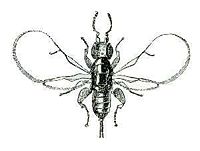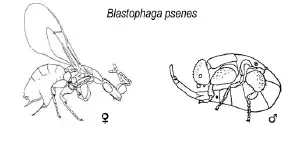Fig wasp
| Fig wasps | ||||||||||||||
|---|---|---|---|---|---|---|---|---|---|---|---|---|---|---|
 Blastophaga psenes
| ||||||||||||||
| Scientific classification | ||||||||||||||
| ||||||||||||||
|
Fig wasp is the common name for wasps of the family Agaonidae, which pollinate figs or are otherwise associated with figs. Many of the wasps currently placed together within this family may not considered to be closely related in an evolutionary sense, but are placed together because of their shared association with figs.
unique harmony rewrite: Among ecological values is the harmonious relationship between fig trees and fig wasps, with the very small wasps pollinating the trees— typically one particular species of wasp for each species of tree— while the flowers provide nourishment and a safe haven for the wasps.
role of males
Overview and description
Fig wasps are members of the order Hymenoptera, one of the largest orders of insects, comprising the ants, bees, wasps, and sawflies, among others. As insects, hymenopterans have three pairs of jointed legs; an abdomen that is divided into 11 segments and lacks any legs or wings; and a body separated into three parts (head, thorax, and abdomen), with one pair of antennae on the head. As true insects, they also are distinguished from all other arthropods in part by having ectognathous, or exposed, mouth parts. Adult hymenopterans typically have two pairs of wings with reduced venation. The hindwings are connected to the forewings by a series of hooks called hamuli. Hymenopterans have compound eyes and the antennae are long, multisegmented, and covered with sense organs (Grzimek et al. 2004). Females have an ovipositor—an organ used for laying eggs—that in some species of wasps, ants, and bees has been modified for a defense function rather than an egg-laying function.
Hymenopterans are divided into the two suborders of Apocrita and Symphyta. Fig wasps belong to the suborder Apocrita with the bees, ans, and other wasps (Gzimek et al. 2004). Broadly defined, wasp is any insect of the order Hymenoptera and suborder Apocrita that is not a bee or ant. In species belonging to Aprocrita, the first abdominal segment is firmly attached to the metathorax and usually separated by a narrow waist (petiole) (Grzimek et al. 2004).
As presently defined, the family Agaonidae, which comprises the fig wasps, is polyphyletic, including several unrelated lineages whose similarities are based upon their shared association with figs. Since classification seeks to arrange species according to shared lineage, efforts are underway to resolve the matter, and remove a number of constituent groups to other families, particularly the Pteromalidae and Torymidae. Thus, the number of genera in the family is in flux. Probably only the Agaoninae should be regarded as belonging to the Agaonidae, while the Sycoecinae, Otitesellinae, and Sycoryctinae might be included in the Pteromalidae. Placement of the Sycophaginae and Epichrysomallinae remains uncertain.
Among the Agaonidae, the female is the more typically appearing insect, while the males are mostly wingless. The males' only tasks are to mate with the females while still within the fig syconium and to chew a hole for the females to escape from the fig interior. This is the reverse of Strepsiptera and the bagworm, where the male is a normally appearing insect and the female never leaves the host.
Figs and fig wasps
Fig is the common name given to any vine, shrub, or tree in the genus Ficus of the mulberry family, Moraceae. (The term also is used for the edible, round to oval, multiple fruit of the common fig, Ficus carica, which is of commercial importance. The fruit of many other species are edible, though not widely consumed.) In addition to the common fig, Ficus carica, the most well known species, other examples of figs include the banyans and the sacred fig (Peepul or Bo) tree.
Most fig inflorescences contain three kinds of flowers: male, short female, and long female. Female fig wasps can reach the ovaries of short female flowers with their ovipositors, but not long female flowers, whose flower part is too long for the wasp to successfully lay her eggs in them. Thus, fig wasps grow in the short flowers, whereas the long flowers become seeds. In figs of this sort, the crunchy bits in the fruit contain both seeds and dead fig wasps almost too tiny to see. However, there are several commercial and ornamental varieties of fig that are self-fertile and do not require pollination; these varieties are not visited by fig wasps.
There typically is only one species of wasp capable of fertilizing the flowers of each species of fig, and therefore plantings of fig species outside of their native range results in effectively sterile individuals. For example, in Hawaii, some 60 species of figs have been introduced, but only four of the wasps that fertilize them have been introduced, so only four species of figs produce viable seeds there. The common fig Ficus carica is pollinated only by Blastophaga psenes.
Life cycle
Hymenopterans are holometabolus insects, meaning they undergo complete metamorphosis in which the larvae differ markedly from the adults. Insects that undergo holometabolism pass through a larval stage, then enter an inactive state called pupa, and finally emerge as adults (imago).
The life cycle of the fig wasp is closely intertwined with that of the fig tree they inhabit. The wasps that inhabit a particular tree can be loosely divided into two groups; pollinating and non-pollinating. The pollinating variety forms a mutually beneficial symbiosis with the tree, whereas the non-pollinating variety is parasitic. Both life cycles, however, are very similar.
Though the lives of individual species differ, a general fig wasp life cycle is as follows. In the beginning of the cycle, a mature female pollinator wasp enters a receptacle ("fruit") through a small natural opening, the ostiole, passes through the mouth of the fig, which is covered in male flowers, and deposits her eggs in the cavity, which is covered in female flowers, by oviposition. Forcing her way through the ostiole, she often loses her wings and most of her antennae. In depositing her eggs, the female also deposits pollen she picked up from her original host fig. This pollinates some of the female flowers on the inside surface of the fig and allows them to mature. After pollination, there are several species of non-pollinating wasps which deposit their eggs before the figs harden. These wasps act as parasites to either the fig or the pollinating wasps. As the fig develops, the wasp eggs hatch and develop into larvae. After going through the pupal stage, the mature male’s first act is to mate with a female. The males of many species lack wings and are unable to survive outside the fig for a sustained period of time. After mating, a male wasp begins to dig out of the fig, creating a tunnel for the females to escape through.
Once out of the fig, the male wasps quickly die. The females leave the figs, picking up pollen as they do. They then fly to another tree of the same species where they deposit their eggs and allow the cycle to begin again.
Genera
Genera currently included in Agaonidae according to the Universal Chalcidoidea Database:
|
|
|
|
ReferencesISBN links support NWE through referral fees
- Grzimek, B., D. G. Kleiman, V. Geist, and M. C. McDade. 2004. Grzimek's Animal Life Encyclopedia. Detroit: Thomson-Gale. ISBN 0787657883
- Rasplus, J.-Y., Kerdelhuse, C., Clainche, I. le & Mondor, G. 1998. Molecular phylogeny of fig wasps. Agaonidae are not monophyletic. Comptes Rendus de l'Academie des Sciences (III) 321(6):517-527
External links
- Video: Interaction of figs and fig wasps Multi-award-winning documentary
- Figs and fig wasps
- Images of fig wasps on Morphbank, a biological image database
Credits
New World Encyclopedia writers and editors rewrote and completed the Wikipedia article in accordance with New World Encyclopedia standards. This article abides by terms of the Creative Commons CC-by-sa 3.0 License (CC-by-sa), which may be used and disseminated with proper attribution. Credit is due under the terms of this license that can reference both the New World Encyclopedia contributors and the selfless volunteer contributors of the Wikimedia Foundation. To cite this article click here for a list of acceptable citing formats.The history of earlier contributions by wikipedians is accessible to researchers here:
The history of this article since it was imported to New World Encyclopedia:
Note: Some restrictions may apply to use of individual images which are separately licensed.

